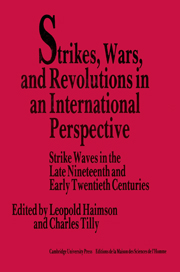 Strikes, Wars, and Revolutions in an International Perspective
Strikes, Wars, and Revolutions in an International Perspective Published online by Cambridge University Press: 25 March 2010
The new class of Metalworkers and the First World War
The First World War induced great changes in the character of the working class and in industrial relations. The slow evolution of industrial relations since the turn of the century, and the very foundations of the social structure were abruptly upset – so much so that it was said that “the war was veritably a typhoon that radically changed the structure of Italian society and modified, at the same time, its social texture.” A new working class emerged, forged in the miliarized factories, changed in its organic composition, younger and more impatient than the one that had fought the big trade unions battles during the Giolitti period.
The Great War altered the patterns of industrial relations that had slowly become established in the Giolittian era. During the war, hiring contracts and collective wage agreements assumed a political and legal significance unknown in earlier legislation. Trade unions and employers discovered different, often compulsory mechanisms for mediating labor conflicts. The more progressive members of the political and administrative classes, and later employers and trade unions, sought to put some order in the customs and regulations that had built up through the years, and to set up an organic and binding system of industrial relations. The great structural changes that took place in industry thus made possible the emergence of a uniform set of rules governing social relations in industrial firms.
To save this book to your Kindle, first ensure [email protected] is added to your Approved Personal Document E-mail List under your Personal Document Settings on the Manage Your Content and Devices page of your Amazon account. Then enter the ‘name’ part of your Kindle email address below. Find out more about saving to your Kindle.
Note you can select to save to either the @free.kindle.com or @kindle.com variations. ‘@free.kindle.com’ emails are free but can only be saved to your device when it is connected to wi-fi. ‘@kindle.com’ emails can be delivered even when you are not connected to wi-fi, but note that service fees apply.
Find out more about the Kindle Personal Document Service.
To save content items to your account, please confirm that you agree to abide by our usage policies. If this is the first time you use this feature, you will be asked to authorise Cambridge Core to connect with your account. Find out more about saving content to Dropbox.
To save content items to your account, please confirm that you agree to abide by our usage policies. If this is the first time you use this feature, you will be asked to authorise Cambridge Core to connect with your account. Find out more about saving content to Google Drive.